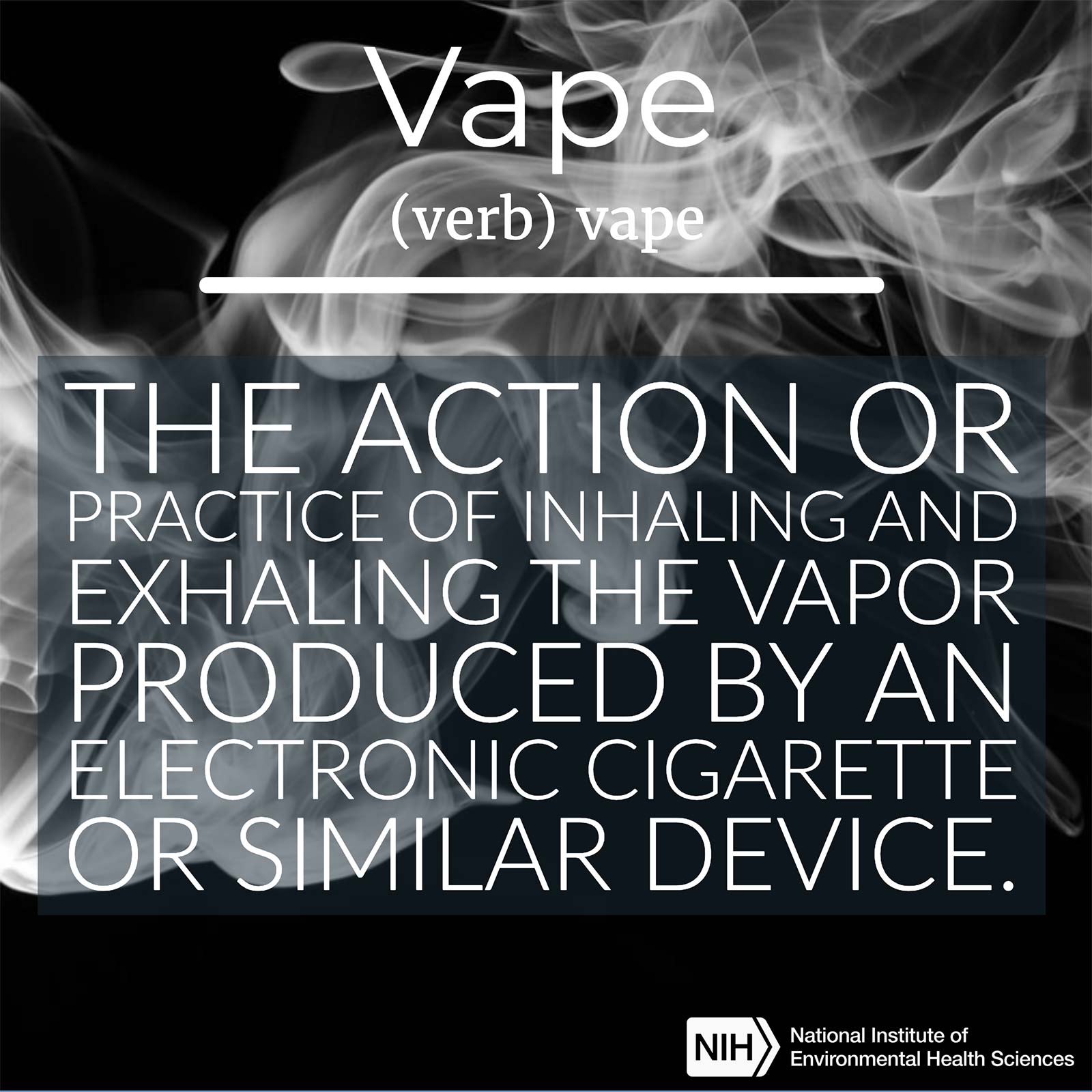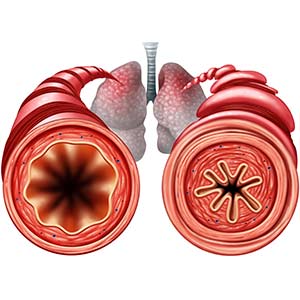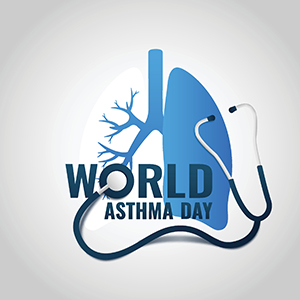Recent scientific studies demonstrate that vaping, or use of e-cigarettes, has measurable effects on organ and cellular health, according to an NIEHS grantee and colleagues. They drew a second important conclusion from their analysis of peer-reviewed research: Not enough is known to say whether e-cigarettes are less harmful to the respiratory system than smoking combustible tobacco products.
 The new paper summarizes the potential effects of vaping on lung health. “E-cigarettes emit volatile carbonyls, reactive oxygen species, furans, and metals such as nickel, lead, and chromium, many of which are toxic to the lung,” the authors wrote.
The new paper summarizes the potential effects of vaping on lung health. “E-cigarettes emit volatile carbonyls, reactive oxygen species, furans, and metals such as nickel, lead, and chromium, many of which are toxic to the lung,” the authors wrote.The review, published Sept. 30 in the British Medical Journal (BMJ), comes amid a growing number of illnesses and deaths that appear to be connected to vaping. According to a U.S. Centers for Disease Control (CDC) Oct. 28 press release, 34 people died as of Oct. 22 in the U.S., as a result of EVALI, for “e-cigarette, or vaping, product use-associated lung injury” (see sidebar).
Massive increase in vaping
 Jordt said that according to BMJ, the full text of the paper was read more than 28,000 times by mid-October and was featured in more than 26 news outlets in the U.S. and abroad. (Photo courtesy of Steve McCaw)
Jordt said that according to BMJ, the full text of the paper was read more than 28,000 times by mid-October and was featured in more than 26 news outlets in the U.S. and abroad. (Photo courtesy of Steve McCaw)Sven-Eric Jordt, Ph.D., an NIEHS grantee at Duke University, was a co-author of the BMJ paper. “This project was long in the making but published at a very crucial time — in the middle of the EVALI epidemic and massive rise in youth vaping,” he said.
“Increases in 2018 in [vaping by] 10th and 12th grade pupils were the largest recorded for any substance in the 44 years that the [Monitoring the Future Survey] has tracked adolescent drug use,” noted Jordt and his co-authors.
Multiple effects on respiratory, immune systems
The team grouped research findings by type of study and charted the results. “E-cigarettes will likely prove to have at least some pulmonary toxicity with chronic and possibly even short-term use,” they wrote. They noted the many lines of human, animal, and in vitro experimental evidence of e-cigarette aerosol effects on the physiology of cells and organs, as well as on immune function.
Compounds like propylene glycol, vegetable glycerin, solvents, nicotine, tetrahydrocannabinols, which are derived from marijuana, and adulterants such as vitamin E may play a role in observed effects.
The scientists cited one study that linked the number of flavors in an e-liquid with its in vitro toxicity. “[That study] also found that the concentrations of vanillin and cinnamaldehyde … correlated with overall toxicity,” they wrote.
In an NIEHS-funded study also published in September, Jordt reported that a compound called pulegone, which is banned as a food additive due to potential carcinogenicity, is present in mint-flavored e-liquids. His team studies compounds in clove and mint flavoring because their anesthetic effects may block the body’s warning system for irritating and toxic chemicals.
The authors stressed that besides what manufacturers put in the liquids, vapers are exposed to compounds formed in the vaping process.
Second-hand vapor, residues
As with smoking, the effects of vaping on people nearby is of concern. “Studies of second-hand vapor exposures are just beginning,” said Jordt.
In addition to vapor itself, residues of nicotine and other chemicals may contaminate surfaces in vaping shops, businesses in the same building, and vapers’ homes, according to one recent report. “These levels build up over time and may represent exposure hazards,” Jordt cautioned.
Crucial research needed
“Importantly, the authors point out that we won’t really know the long-term human health effects associated with e-cigarette vaping until the middle of this century,” said NIEHS Program Director Fred Tyson, Ph.D. He pointed to a critical set of research questions identified in the review.
 “This is a comprehensive, state-of-the-art review on the potential health effects associated with vaping and e-cigarettes,” said Tyson, shown above at an NIEHS seminar. (Photo courtesy of Steve McCaw)
“This is a comprehensive, state-of-the-art review on the potential health effects associated with vaping and e-cigarettes,” said Tyson, shown above at an NIEHS seminar. (Photo courtesy of Steve McCaw)- Does inhaled nicotine cause direct pulmonary toxicity?
- Do e-cigarettes affect adolescent lung development?
- What is the effect of vaping on vulnerable populations, such as those with asthma, chronic obstructive pulmonary disease, and other pre-existing conditions?
- Does e-cigarette use lead to immunosuppression?
Challenges to study design
To answer these questions, scientists must overcome a number of thorny challenges, according to the authors.
- Minimal information from vendors about the contents of e-liquids.
- Lack of a standard e-cigarette device, liquid, and aerosol generation method.
- Devices may be obsolete by the time a study is finished.
- Devices differ — for example, Juul contains 59 milligrams per milliliter (mg per mL) nicotine in the U.S. and 18 mg per mL in the U.K.
- Ethical considerations around studying potentially harmful substances in participants who have never smoked.
These questions may have something to do with the inconsistent findings from studies of smokers who transitioned to e-cigarettes. “Saying with certainty that e-cigarettes are safer than combustible cigarettes is impossible,” the authors concluded.
Citations:
Gotts JE, Jordt SE, McConnell R, Tarran R. 2019. What are the respiratory effects of e-cigarettes? BMJ 366:I5275.
Khachatoorian C, Jacob P 3rd, Sen A, Zhu Y, Benowitz NL, Talbot P. 2019. Identification and quantification of electronic cigarette exhaled aerosol residue chemicals in field sites. Environ Res 170:351−358.
Sassano MF, Davis ES, Keating JE, Zorn BT, Kochar TK, Wolfgang MC, Glich GL, Tarran R. 2018. Evaluation of e-liquid toxicity using an open-source high-throughput screening assay. PLoS Biol 16:e2003904.
 Studies have shown vaping’s widespread effects on the respiratory system, from changes in sputum and the alveoli, which are the crucial gas exchange mechanisms of the lung, to cellular toxicity and altered gene expression in nasal passages. (Image reproduced from BMJ, JE Gotts, SE Jordt, R McConnell, and R Tarran, 366:l5275, 2019, with permission from BMJ Publishing Group Ltd.)
Studies have shown vaping’s widespread effects on the respiratory system, from changes in sputum and the alveoli, which are the crucial gas exchange mechanisms of the lung, to cellular toxicity and altered gene expression in nasal passages. (Image reproduced from BMJ, JE Gotts, SE Jordt, R McConnell, and R Tarran, 366:l5275, 2019, with permission from BMJ Publishing Group Ltd.) 









